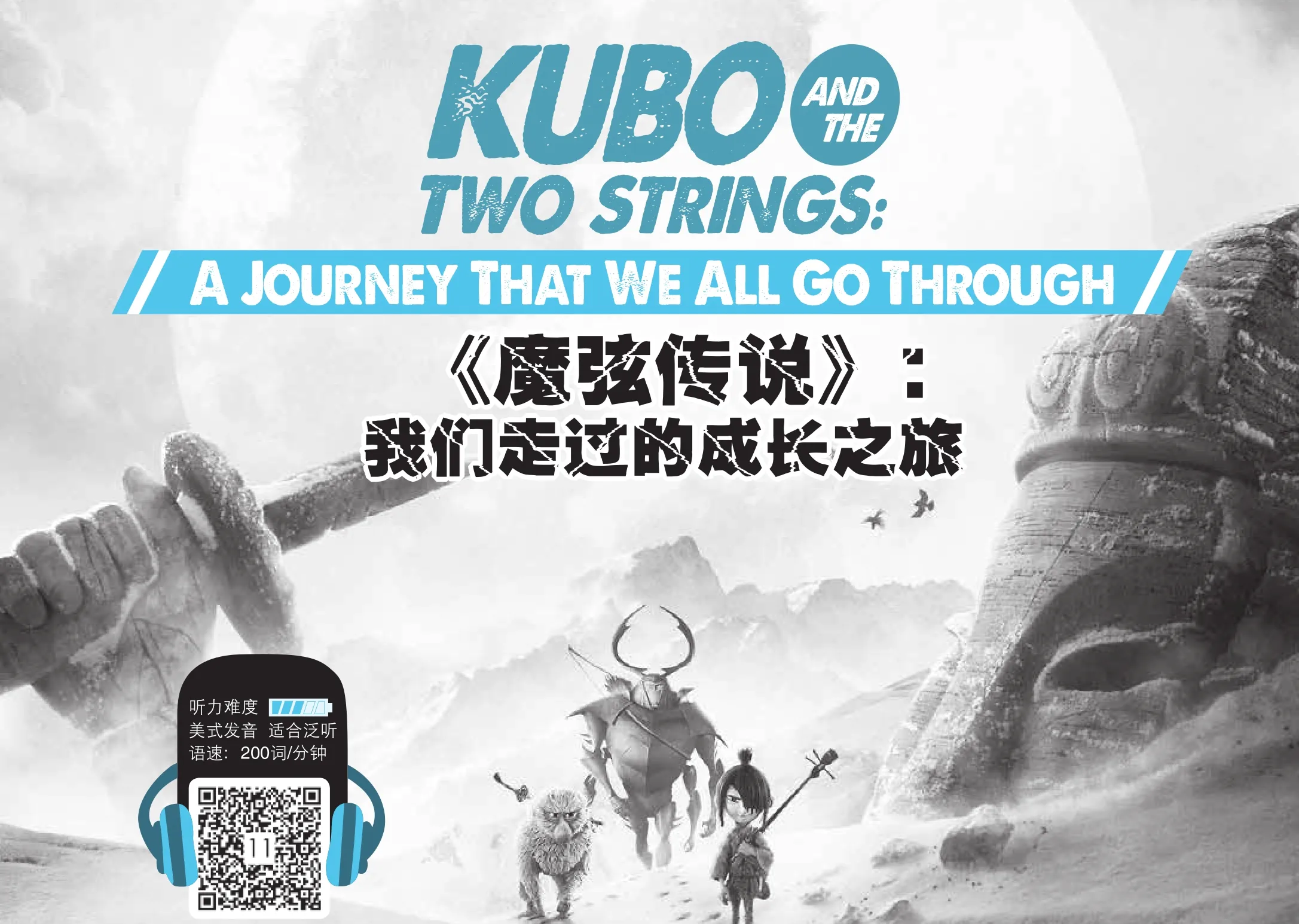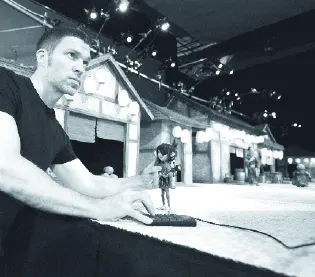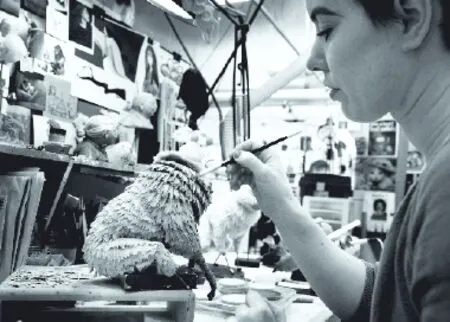KUBO AND THE TWO STRINGS:A JOURNEY THAT WE ALL GO THRORGH
⊙ By Travis Knight
翻译:思苇
KUBO AND THE TWO STRINGS:A JOURNEY THAT WE ALL GO THRORGH
《魔弦传说》:我们走过的成长之旅
⊙ By Travis Knight
翻译:思苇

今年开年上映的第一部动画片是《魔弦传说》。这部定格动画(stop-motion animation)是美国莱卡动画工作室花了五年时间才完成的心血力作,讲述了一个名叫久保的少年面对步步逼近的巨大危机,踏上寻找父亲留下的秘宝的旅途。这种史诗式的冒险故事一直被认为是定格动画几乎不可能做到的题材,那么大屏幕上那些充满东方风情的惊人画面又是怎么实现的呢?一起来听本片导演讲讲幕后的故事吧!
Host:While the Disney and Pixar brands have becomesynonymouswith[同义]blockbuster[卖座电影]animated[动画的]films, the small Portland-based studio behind Kubo has been quietly making its mark. Since it was founded a decade ago, Laika Entertainment has earned three Oscar nods for animation for its films Coraline, ParaNorman and The Boxtrolls. The head of Laika is Travis Knight. Give us some of the basics of stop-motion animation 101. Like, when I look at this little character of Kubo, is he a plastic model, a clay model?
Travis Knight(Director):He’s a littlepuppet[人偶]. The basic way it works is that you have a puppet. They have a steelarmature[支架], which is, like, a little skeleton inside their body. And they’re covered with asilicon[硅]skin. And, you know, they have cloth costumes. And in a lot of ways, it’s like a live-action production house. It’s justin miniature[小型]. We still have the same departments. We have, you know, costuming and hair. And then we…you know, we move these things aframe[画面]at a time.And the thing that we’ve done differently at Laika is that we try tomerge[混合]technology and forward-thinkinginnovation[创新]with this hundred-year-old art andcraft[工艺]. And it’s thatfusion[融合]of those things that makes the productions look so interesting, I believe.
Host:Western animation—I mean, cinema in general, frankly—doesn’t have the best reputation in terms of representing Asian countries and cultures. And so, like, when you’re trying to set a story in a place like Japan, how do you walk that line of, kind of, staying true to the atmosphere and the sense of place without falling intostereotypes[刻板形象]?
Travis:For the first two, three years of a project, all we’re doing is developing thescript[脚本], the story, the characters, the world. And as part of that process, you are, you know, diving really deep intoregional[地区的]and historical research to make sure that you’re grounding your fairytale in the real world. You know, for me, I was eight years old when I was first introduced to Japan. Itagged along[尾随]with my dad on one of his business trips to Japan. And from the moment I set foot there, it was like I’d been transported to another world. It was so completely different than anything that I’d ever experienced. And so for me, that was the beginning of a love affair…well, a lifelong love affair.
Host:How old were you when you first started working with any kind of crafts or doing art?
Travis:Yeah, I’ve been doing it my whole life. I was a fairly lonely kid growing up. And, you know, a lot of that time spent alone I was creating. I was writing stories. I was making music. And it was just a way of expressing myself. It’s something I’ve always beendrawn to[吸引到].
Host:Is it me, or do you and Kubo have a lot in common? That childhood soundsoddly[奇妙地]familiar.


Travis:We do have a lot in common. He’s an artist. He’s a musician. He’s a storyteller. He’s an animator, really, when you think about the way he brings these things to life.
Host:And lonely.
Travis:And lonely. And the…you know, the center of his universe is his mother, and that was true for me as well. And this film, you know, explores that time in our lives when those things begin to shift and thenirrevocably[不能挽回地]change, when we crossthe Rubicon[界线]from childhood to adulthood and the things that we gain and the things that we leave behind along the way, which can often be bittersweet. But it is a fundamental journey that we all go through.CY

Give us some of the basics of stop-motion animation 101.
在美国大学课程系统中,编号101的课程一般是指某个专业开设的、面向入门者的基础课程。后来,人们常用“名词+101”这种搭配来表示某方面的入门知识或者基本窍门,如:I think you really need to learn more aboutjob search 101. (我觉得你确实需要多掌握一点求职基本功。)

主持人:尽管迪士尼与皮克斯两大品牌已经成为卖座动画片的同义词,少年久保背后这家位于美国波特兰市的小工作室也低调地闯出了一番天地。成立已有十年的莱卡娱乐公司凭借他们的《鬼妈妈》《通灵男孩诺曼》和《盒子怪》三度获得奥斯卡动画部门的肯定。特拉维斯·奈特是莱卡动画“掌门人”。给我们讲讲定格动画的入门基础吧,比如我看到久保这个小男孩,他是塑胶模型吗,还是黏土模型?
特拉维斯·奈特(导演):他是个小偶人。定格动画的基本原理就是你得有个偶人,它里面有个钢制支架,就像是它体内的一副小骨架,外面是硅胶皮肤。你瞧,偶人也要穿衣服。从很多方面来说,动画工作室就和真人摄影厂差不多,只是规模比较小罢了。我们也有同样的制作部门,也有服装和发型什么的。然后……你瞧,我们要移动这些拍摄对象,一次拍一个画面。在莱卡这里,我们有个与众不同的做法,就是尝试将科学技术、前沿创新与这种上百年的手艺结合在一起。正是这几大要素的混搭让我们的成品看起来那么有趣,我是这么认为的。
主持人:西方动画——我的意思是,老实说,西方电影从整体而言,在如何表现亚洲国家与亚洲文化这一方面的名声一直不怎么好。因此,当你要将故事设定在一个像日本这样的地方,你是如何保持平衡的呢?如何做到既能真实还原当地的氛围与感觉,又不会落入刻板俗套呢?
特拉维斯:在一个项目的头两三年,我们要做的就是埋头设计剧本、故事、人物,以及背景。在设计过程中,你要对故事发生地进行深入的地区及历史研究,确保你的童话故事能以真实世界作为基础。你瞧,对我来说,我在八岁那年第一次接触到日本文化。当时我爸爸经常到日本出差,有一次把我也捎上了。我第一次踏足那片土地时,那种感觉就像一下子被带到另外一个世界似的,和我之前经历过的所有东西都不一样。所以,对我来说,那就是迷恋日本的开始,这是一种延续一生的热爱。
主持人:你是几岁开始玩手工、搞艺术的呢?
特拉维斯:你瞧,我这一辈子都在搞艺术。从小到大,我一直是个很孤独的孩子,大部分独处的时间都在搞创作。我会写故事,也会创作音乐。这一直是我表达自己的方式,我对此情有独钟。
主持人:只有我是这么想的吗,还是说你和久保确实有很多共同点?这个童年听起来有点耳熟啊。
特拉维斯:我们确实有很多共同点。他是个艺术家、音乐家,还会讲故事——你想想他是怎么让那些小折纸动起来的,从这一点来说,他简直是个动画师。
主持人:他还很孤单。
特拉维斯:他很孤单。而且……你瞧,对久保来说,妈妈就是整个世界的中心,对我来说也一样。这部电影探讨的是我们人生的这么一个阶段,各种事情开始发生转变,最后彻底变样,不可挽回。我们越过界线,从少年长大成人,一路上得到了一些东西,将另外一些东西抛诸脑后——这常常是一个苦乐参半的过程,但也是我们所有人都要经历的一段重要旅程。

